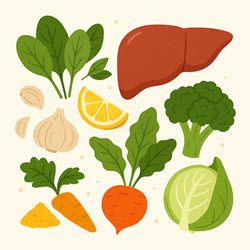Can Heartburn Drugs Affect Memory?
Liver Detox with Nutrition, and natural health articles!
Hi and Happy May!
Thanks for reading the latest issue of HEALTHFULTIPS. We love sharing our newsletter! I am always looking for feedback from our readers! We are not really selling anything, we just want to provide you with chiropractic and natural health info. Take our survey and let us know what you think of this newsletter.
Check out this 4 minute meditation that I uploaded
Enjoy the issue!
TABLE OF CONTENTS
Why Pain Isn't the Problem-It's the Signal: A Chiropractor's View
Chiropractic vs. Surgery: When to Choose a Natural Approach
Did you know?
Can Heartburn Drugs Affect Memory?
Liver Detox with Nutrition: Support Your Body Naturally
Words of Wisdom
Researching Chiropractic
Humor
References
Why Pain Isn't the Problem-It's the Signal: A Chiropractor's View
A woman once visited a chiropractor after years of struggling with migraines. She had pursued countless options aimed at stopping the pain, but nothing lasted. Her case wasn't unique. When the chiropractor evaluated her spine, a misalignment at the upper cervical region was uncovered. The pain wasn't a malfunction—it was a message.
Pain acts as a signal from the nervous system, alerting the body to interference or imbalance. It doesn't exist in isolation. The nervous system coordinates every action, every function. When communication through the nerves is disrupted, the body speaks up—sometimes with sharp, persistent pain, other times with subtle discomfort. Either way, it's not the pain that's broken. It's pointing to what needs correction. [1]
Pain as a Guide, Not an Enemy
Chiropractic care isn't built around chasing pain. Practitioners observe it, respect it, and use it as a guide. Often, the place that hurts isn't the origin of the problem. A misalignment somewhere else in the spine may pull or irritate structures, creating dysfunction at a distance.
A teenage patient came in with chronic knee pain. There had been no fall, no accident. Upon examination, it became clear his pelvis was out of balance. The resulting stress cascaded downward, forcing his knees to compensate. Once spinal alignment was restored, the knee pain faded, not through direct action on the knees, but by removing the cause of the pressure.
The Body Knows What to Do
Chiropractors focus on locating and reducing nerve interference so the body can restore proper function. This principle is rooted in natural law: the body, when unimpeded, knows how to heal itself. The chiropractor doesn't fix the body; they remove what's blocking it from doing its job.
Seeing pain as a messenger rather than a malfunction changes everything. Covering it up may offer temporary relief, but it quiets a necessary signal. By honoring that signal, chiropractors uncover what the body is truly asking for: function, coordination, and freedom from interference.
Chiropractic vs. Surgery: When to Choose a Natural Approach
Several years ago, a man named Steve was advised to undergo surgery for a recurring back issue. Sitting for more than ten minutes caused him sharp discomfort. Rather than proceed immediately, he explored other options. Curious about stories he'd heard, Steve visited a chiropractor. After a few weeks of regular care, his pain began to ease. Today, he hikes regularly and hasn't revisited the idea of surgery.
Experiences like Steve's are not uncommon. Many individuals dealing with structural imbalance or nerve stress respond well to chiropractic care, especially when the underlying problem stems not from torn tissue, but from misalignment or pressure on the nervous system.
Chiropractic methods aim to work with the body's natural ability to restore function. Practitioners use their hands, not machines or drugs, to make precise corrections that support better movement and nerve communication.
Of course, there are moments when surgery is appropriate—severe trauma, growths, or fractures may require it. But decisions like that benefit from patience. Not all pain signals significant damage. In many cases, discomfort may reflect irritation or restriction rather than a structural failure requiring invasive repair.
Chiropractors take time to listen to the body's signals and assess how best to respond. An adjustment isn't meant to silence symptoms but to support function. Given the chance, the body often responds with improved strength, balance, and comfort.
Steve later shared that he didn't just want relief from pain—he wanted to feel like himself again. For many, that's the true goal. Surgery can address certain conditions, but it comes with risks and permanence. Chiropractic care offers a way forward without locking the body into irreversible changes.
A surgical procedure can't be undone. An adjustment can. That difference matters. [2]
Sometimes, the best answer is the one that allows the body room to speak and space to heal.
Did you know?
Leonardo da Vinci could write with one hand while drawing with the other, at the same time. He was ambidextrous and often used mirror writing in his notebooks.
Despite being one of history's most famous painters, Leonardo only completed about 15 paintings in his lifetime. He was known for being a perfectionist who often abandoned projects.
Can Heartburn Drugs Affect Memory?
Popular Antacids and a Surprising Risk
Many people turn to over-the-counter medications like Prilosec, Protonix, or Nexium after a heavy or spicy meal. These proton pump inhibitors (PPIs) are commonly used to ease the burn of acid reflux. But a 2016 study suggests that frequent use in older adults might carry a hidden cost: a higher risk of developing dementia.
What the Research Found
The study, published in JAMA Neurology, followed 73,679 individuals aged 75 and older who were dementia-free when the study began. Participants who took PPIs regularly—at least one prescription per quarter—were found to have a 44% greater chance of being diagnosed with dementia over eight years compared to non-users (3).
Possible Reasons for the Link
As the body ages, the blood-brain barrier may become more porous, making it easier for medications to reach the brain. Some researchers believe this could allow PPIs to interfere with enzymes and increase levels of beta-amyloid and tau proteins—markers often seen in Alzheimer's disease. There's also evidence that PPI use can lower vitamin B12 levels, which has been linked to cognitive decline.
What Doctors Are Saying
Experts agree that more research is needed to understand how—or if—these drugs directly influence brain health. However, some doctors have already discussed the findings with patients. Dr. Malaz Boustani, from the Indiana University Center for Aging Research, suggests lifestyle changes to reduce the need for medication. These include eating smaller meals, staying upright after eating, and avoiding common triggers like chocolate and coffee.
Small Adjustments, Big Difference
Anyone concerned about the long-term effects of PPIs is encouraged to speak with their healthcare provider. For some, the benefits of the medication may outweigh the risks. For others, a few small adjustments to diet and habits could offer the same relief, without the added worry.
Liver Detox with Nutrition: Support Your Body Naturally
Your liver works 24/7 to filter toxins, process nutrients, and support digestion. But in today's world, filled with processed foods, chemicals, and stress, your liver can get overburdened.
The good news? You don't need extreme cleanses. You can support your liver naturally with everyday foods.
Why Liver Health Matters
Think of your liver as your body's built-in filtration system. When it's running smoothly, you feel energized, clear-headed, and balanced. But signs like fatigue, bloating, and dull skin can show up when it's overwhelmed.
Supporting your liver through nutrition helps it do its job more effectively.
Top Liver-Supporting Foods
Add these to your diet regularly:
•Leafy greens (spinach, kale, dandelion): rich in chlorophyll, which helps remove environmental toxins.
•Cruciferous vegetables (broccoli, cauliflower, Brussels sprouts): boost detoxification enzymes.
•Beets: support bile flow and help flush out heavy metals.
•Garlic: activates enzymes that break down and eliminate toxins.
•Citrus fruits (especially lemons): high in vitamin C, which supports the production of glutathione.
•Turmeric: contains curcumin, which reduces inflammation and promotes liver cell repair.
The liver is central to detoxification and responds to environmental and dietary exposures, making nutrition critical to its function. [4]
Hydration and Fiber: Unsung Heroes
Drinking water helps your liver flush out toxins. Aim for 8-10 cups per day. Pair that with fiber-rich foods—like oats, legumes, flaxseeds, and apples- to keep waste moving out of your system.
Skip the Gimmicks
Forget fad detoxes or expensive supplements. Your liver doesn't need a cleanse—it needs daily support from real food, clean water, and reduced exposure to toxins.
Final Tip
Take small steps every day. Eat more greens, squeeze lemon into your water, and add turmeric to your meals. Your liver will thank you.
Words of Wisdom
What you think, you become. - Buddha
Success usually comes to those who are too busy to be looking for it. - Henry David Thoreau
Researching Chiropractic
Chiropractic clinical case histories have been a regular feature of our patient newsletter since its inception. There seems to be no limit to the health problems that respond positively to chiropractic care. How many people suffering, reliant on medication and drugs, and facing a life of limitation could be helped by chiropractic care?
Probably most of them.
A 3-year-old girl with developmental delays and neurological challenges, including hypotonia, delayed speech, and emotional dysregulation, underwent chiropractic care utilizing the Melillo Method. This approach focused on primitive reflex integration, sensory integration, and multimodal therapies. Post-treatment, the patient exhibited improvements in neurological function and developmental milestones.[5]
A 74-year-old woman presented with a low heart rate, fatigue, and lightheadedness. Over an 8-week period, she received six Atlas Orthogonal chiropractic adjustments. Following the third adjustment, she noted improvements in heart rate, fatigue, and dizziness. Heart rate variability analysis showed a shift from parasympathetic to sympathetic tone, and post-radiographs demonstrated a reduction in upper cervical subluxation.[6]
Humor
At the zoo, I saw a baguette in a lion's enclosure.
Turns out it was bread in captivity.
I told a joke to a group of cows.
They didn't laugh.
I guess it was just utterly terrible
Bye
Please write or stop by and give us your feedback. Are there any subjects you'd like to hear about? Anything you dislike? Feedback is always important to us. Tell your friends!







